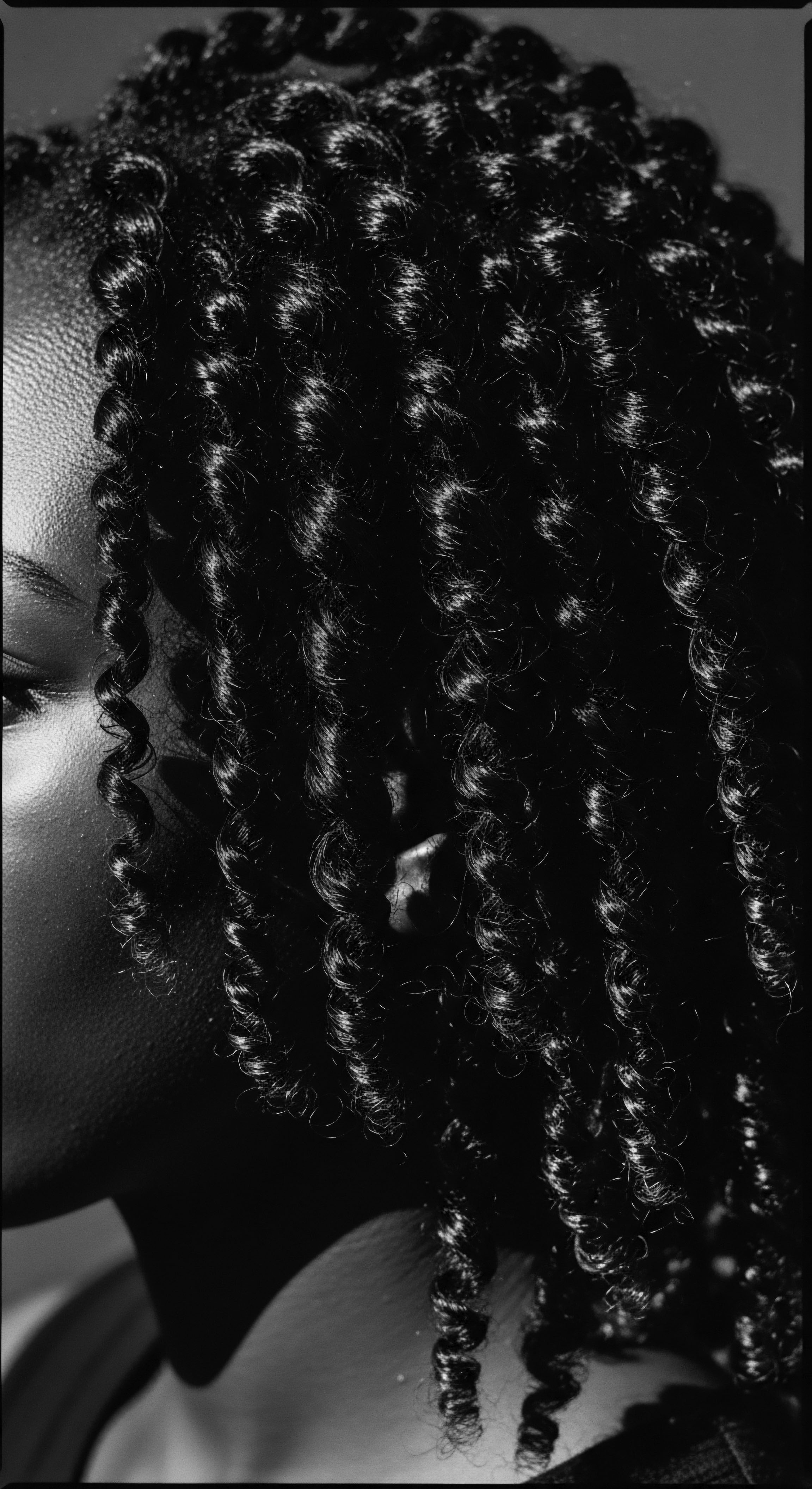
Fundamentals
The journey into understanding Traditional Shea Butter begins with recognizing its humble yet profound origins, rooted deeply within the verdant landscapes and ancestral wisdom of West Africa. At its simplest, Traditional Shea Butter stands as a rich, creamy emolient, meticulously extracted from the nuts of the shea tree, scientifically known as Vitellaria Paradoxa. This remarkable tree, indigenous to the vast savanna belt spanning from Senegal to Uganda, holds a revered place in countless communities, often referred to as the “Tree of Life” or “Women’s Gold.” Its fruit, akin to a plum, yields the precious shea nut, which is the sole source of this butter.
For generations, the process of transforming shea nuts into butter has remained a testament to communal knowledge and diligent hands. Harvesting the fallen fruits, typically between June and September, marks the initial step. These nuts are then carefully shelled, revealing the kernel within. The kernel undergoes a sequence of actions ❉ crushing, roasting, and grinding, eventually forming a thick, dark paste.
This paste is then kneaded by hand, with water added, a labor-intensive practice that gradually separates the butter from the impurities. The pure butter rises, is skimmed off, and allowed to cool, solidifying into the familiar creamy substance.
Traditional Shea Butter represents a centuries-old legacy, a nourishing gift from the shea tree, extracted through time-honored communal practices.
Its fundamental usefulness for hair lies in its inherent capacity to provide exceptional Moisture and Protection. Unlike many commercial products, Traditional Shea Butter offers a natural, unadulterated balm. It helps to seal moisture within the hair strands, an essential aspect for textured hair types that often experience dryness due to their unique structural formation. This elemental biological compatibility with textured hair has long been acknowledged, passed down as practical wisdom through family lines.

The Shea Tree ❉ A Source of Ancient Sustenance
The Vitellaria Paradoxa tree itself is a wonder, thriving in dry, challenging climates where other crops might fail. It takes a patient twenty to thirty years to yield its first fruits, underscoring the long-term vision inherent in traditional practices surrounding its cultivation and use. The deciduous nature of its dark green, leathery leaves, shedding during the dry season, allows the hermaphroditic, yellow-green flowers to bloom, attracting essential pollinators like flies and bees. This biological rhythm dictates the harvest cycle, directly connecting the seasonal flow of nature to the rhythms of human sustenance and care.
The cultural reverence for the shea tree extends beyond its utility. It is often regarded as a sacred entity, deeply integrated into the spiritual and communal fabric of West African societies. Many traditions observe prohibitions against felling these trees, emphasizing their vital role in sustaining both economic well-being and a profound sense of cultural continuity. The planting of shea trees can even commemorate significant family milestones, such as childbirth or the inheritance of land, weaving the tree directly into the personal and collective stories of generations.

Intermediate
Expanding upon its elemental recognition, the intermediate understanding of Traditional Shea Butter delves into the intricate societal web surrounding its production and the deeper implications of its botanical constituents. The adjective “traditional” here specifies a crucial distinction ❉ it refers to shea butter produced through methods that have remained largely unchanged over centuries, relying on manual processes and community involvement rather than industrial machinery or chemical interventions. This traditional artisanal method preserves the integrity of the butter, allowing it to retain a higher concentration of naturally occurring vitamins and bio-actives.
The appellation “Women’s Gold” is not merely a poetic flourish; it speaks to the profound economic and social significance of shea butter production. In many West African communities, the labor-intensive process of harvesting, processing, and marketing shea nuts and butter rests almost exclusively with women. This collective endeavor provides a primary source of income for millions of women, fostering economic stability within households and bolstering local economies. This deep economic and social link underscores how this natural resource serves as a cornerstone of women’s empowerment and community resilience.
Beyond its cosmetic application, Traditional Shea Butter is a profound symbol of economic autonomy and communal solidarity among West African women.

A Deeper Look at Traditional Processing
The multi-stage process of creating Traditional Shea Butter is a ritual in itself, demanding skill, patience, and collective effort. After the nuts are gathered, they are boiled and then sun-dried, a step that prevents germination and aids in storage. The outer pulp is removed, and the inner kernels are typically roasted, a step that imparts the characteristic nutty aroma and helps to release the oils. Grinding these roasted kernels yields a fine powder, which is then gradually kneaded with water.
This kneading, often performed by hand for hours, separates the butterfat from the other components, allowing the pure butter to coagulate and be collected. This meticulous, hands-on approach ensures that the butter retains its natural color, which can range from creamy ivory to light yellow, and its distinctive earthy scent.
- Harvesting ❉ Shea fruits are collected when they fall from the tree, a natural indicator of ripeness.
- Crushing ❉ Dried kernels are broken into smaller pieces, often using stones or simple tools.
- Roasting ❉ Crushed kernels are carefully roasted, enhancing the butter’s aroma and aiding oil extraction.
- Grinding ❉ Roasted kernels are ground into a fine paste, the raw material for the butter.
- Kneading & Separation ❉ The paste is mixed with water and kneaded to isolate the butterfat.

The Botanical Blueprint ❉ Beneficial Compounds
The efficacy of Traditional Shea Butter in hair care, particularly for textured strands, stems from its rich and complex biochemical makeup. It contains a significant proportion of fatty acids, notably Oleic Acid and Stearic Acid, which are instrumental in providing deep moisture and creating a protective barrier on the hair shaft. These fatty acids mimic the natural lipids found in hair and skin, allowing for effective absorption and sustained hydration.
More significantly, Traditional Shea Butter is celebrated for its high content of Unsaponifiable Matter. While typical oils might contain 1-2% unsaponifiables, shea butter boasts between 7-12%. These compounds are not converted into soap during saponification (the process of turning fat into soap), and they include valuable components such as triterpene alcohols, cinnamic acid esters, and phytosterols.
These elements contribute to shea butter’s anti-inflammatory properties, its ability to assist with cell regeneration, and even offer some natural UV protection. For textured hair, this translates to not only surface-level conditioning but also profound restorative benefits, aiding in scalp health and overall hair resilience.
| Component Group Fatty Acids |
| Specific Compounds Oleic, Stearic, Linoleic, Palmitic |
| Traditional Understanding (Implied) "Softens and protects hair." |
| Scientific Elucidation for Hair Provides deep lipid restoration, seals moisture, and reduces frizz. |
| Component Group Vitamins |
| Specific Compounds Vitamin A, Vitamin E, Vitamin F |
| Traditional Understanding (Implied) "Nourishes hair and scalp." |
| Scientific Elucidation for Hair Acts as an antioxidant, supports cell renewal, and guards against environmental damage. |
| Component Group Unsaponifiables |
| Specific Compounds Triterpenes, Cinnamic Acid Esters, Phytosterols |
| Traditional Understanding (Implied) "Heals and soothes the scalp." |
| Scientific Elucidation for Hair Offers anti-inflammatory properties, aids in healing, and provides mild UV defense. |
| Component Group The synergy of these natural compounds underscores Traditional Shea Butter's enduring relevance in ancestral hair care, affirmed by contemporary scientific understanding. |

Academic
The academic definition of Traditional Shea Butter transcends a mere catalog of its properties; it positions this revered substance as a nexus of ethnobotanical wisdom, historical continuity, and bio-cosmetic efficacy, particularly within the context of textured hair heritage. To understand Traditional Shea Butter at this elevated register is to comprehend it as the unrefined, artisanally processed lipid extracted from the kernel of the Vitellaria Paradoxa (or Butyrospermum Parkii) nut, distinguished by its preservation of a high unsaponifiable fraction and its embodiment of centuries of intergenerational knowledge surrounding hair care and community well-being in the West African savanna. This deep understanding recognizes not just its chemical composition, but also its profound socio-cultural embedding, reflecting a sophisticated interplay between ecological understanding, communal labor, and identity formation across African diasporic experiences.

Echoes from the Source ❉ Botanical and Chemical Delineation
The Vitellaria Paradoxa tree, a member of the Sapotaceae family, is a keystone species across the Sudano-Sahelian zone, flourishing in a narrow belt of over 20 countries. Its ecological resilience in semi-arid conditions underscores its importance as a consistent resource for indigenous communities. The lipid profile of its extracted butter is uniquely characterized by a high proportion of saturated fatty acids, predominantly Stearic Acid (35-45%) and Oleic Acid (40-50%), with lesser amounts of linoleic, palmitic, and arachidic acids. This fatty acid composition contributes to its semi-solid state at ambient temperatures and its exceptional emollient capabilities.
What sets Traditional Shea Butter apart within the realm of natural fats is its remarkably high percentage of non-saponifiable compounds, often ranging from 7% to 12%, a concentration significantly greater than other plant oils like avocado oil. These unsaponifiables encompass a complex array of bioactive molecules, including triterpene alcohols (such as alpha-amyrin, lupeol, and butyrospermol), cinnamic acid esters, tocopherols (Vitamin E), carotenoids (provitamin A), and phytosterols. These components confer the butter’s documented anti-inflammatory, antioxidant, and healing properties, which are invaluable for mitigating scalp irritation, reducing oxidative stress on hair follicles, and supporting the overall health of the hair fiber. The presence of cinnamic acid esters, in particular, offers a degree of natural ultraviolet radiation protection, a historically relevant attribute for hair and skin care in sun-drenched regions.
This biochemical richness, meticulously preserved through traditional cold-pressing and hand-kneading methods, contrasts sharply with industrially refined shea butter, where high heat, chemical solvents (like hexane), and deodorization processes can significantly diminish the concentration and bioavailability of these delicate unsaponifiable fractions, altering its physical properties and reducing its therapeutic potential. The ivory to yellowish hue and characteristic nutty, smoky aroma of traditional butter are direct indicators of this unadulterated state and its retained phytochemical complexity.

The Tender Thread ❉ Living Traditions and Hair Heritage
The understanding of Traditional Shea Butter is incomplete without acknowledging its profound integration into the hair heritage of Black and mixed-race communities, a practice spanning millennia. Before the transatlantic slave trade, West African societies viewed hair as a powerful communicative tool, signifying status, age, ethnicity, social rank, and even life events. Elaborate braids, intricate patterns, and distinctive adornments were not merely aesthetic choices; they comprised a visual language. In this rich cultural context, shea butter was not merely a cosmetic product; it was an indispensable tool for maintenance, protection, and symbolic expression of these complex hairstyles.
A particularly compelling historical example of this deep connection emerges from archaeological research. Evidence of shea butter production has been unearthed at the Saouga Archaeological Site in Burkina Faso, with findings dating from 100 to 1700 CE, definitively demonstrating its ancient and sustained use within these communities. This archaeological confirmation pushes the understanding of shea butter’s importance far back into antiquity, grounding its contemporary use in an unbroken lineage of ancestral wisdom.
It is not merely a product of recent popularity, but a living artifact of enduring human ingenuity and cultural continuity in hair care. This historical continuity speaks volumes to its efficacy and the deep knowledge held by African women about its properties and application for diverse textured hair types.
Traditional Shea Butter acts as a tangible link across generations, embodying an ancient wisdom of hair care passed down through time.

Communal Care and Cultural Symbolism
Hair care rituals in pre-colonial and traditional African societies were profoundly communal. Women often gathered together to braid and style each other’s hair, a practice that spanned hours and served as a vital forum for socialization, storytelling, and the strengthening of intergenerational bonds. In these settings, Traditional Shea Butter was a central element, its application a tactile expression of care, love, and shared cultural identity.
It provided the necessary lubrication and pliability for intricate styling, while also nourishing the scalp and strands against environmental stressors. This collective practice imbued the butter with a meaning beyond its physical properties, making it a symbol of unity and inherited tradition.
The significance of Traditional Shea Butter extends into spiritual and medicinal realms. In many communities, the shea tree itself is considered sacred, embodying protection, purity, and fertility. The butter, therefore, carries this reverence, often used in rituals and ceremonies. For hair, this translated to its use not only for physical well-being but also as a means of connecting with ancestral energies and ensuring spiritual cleansing and healing.
Its application to hair was understood to offer physical healing for conditions like dryness and irritation, while also safeguarding the wearer from harmful influences. This holistic understanding of beauty and wellness, where physical care is intertwined with spiritual equilibrium, distinguishes the traditional approach to shea butter.

Economic Autonomy and Social Resilience
The socio-economic landscape surrounding Traditional Shea Butter production highlights its critical role in women’s economic empowerment. Across the “Shea Belt,” an estimated 3 Million Women are directly or indirectly involved in the shea sector. This activity, which includes harvesting, processing, and selling, provides a significant income source for these women, often constituting a quarter to half of their total household earnings. (Tweneboah Kodua et al.
2018). This economic independence translates into greater agency for women in household decision-making, including the ability to fund children’s education and access healthcare, demonstrating a direct link between traditional livelihoods and improved family well-being.
A survey conducted by USAID in 2010 in a village in Burkina Faso found that for every $1,000 of Shea Nuts Sold, an Additional $1,580 in Economic Activities was generated within the village, reflecting the ripple effect of this traditional industry on local economies. Despite its significance, the traditional shea industry faces challenges, including market volatility, competition from refined products, and the impact of climate change on shea tree populations. These factors place ongoing pressure on ancestral practices and the livelihoods of millions.
- Community-Based Production ❉ The majority of traditional shea butter is produced by women’s cooperatives, employing ancestral techniques passed down through generations.
- Economic Independence ❉ Income derived from shea sales empowers women, allowing greater control over household finances and contributing to family welfare.
- Cultural Preservation ❉ The continuation of traditional processing methods safeguards indigenous knowledge and cultural heritage associated with the shea tree.
- Environmental Stewardship ❉ Traditional practices often involve sustainable harvesting, recognizing the long-term health of the shea parklands.

The Unbound Helix ❉ Modern Validation of Ancestral Practices
Contemporary trichological and dermatological science increasingly affirms the wisdom embedded in ancestral uses of Traditional Shea Butter. The intricate helical structure of textured hair—with its unique curl patterns, varying porosity, and susceptibility to dryness—finds a natural ally in the butter’s composition. The high concentration of fatty acids serves as a potent emollient, providing substantial lubrication and moisture retention that is particularly beneficial for hair types prone to dehydration and breakage. Scientific investigation into the Unsaponifiable Fraction confirms its anti-inflammatory actions, which are crucial for maintaining a healthy scalp microbiome, a foundational element for optimal hair growth and vitality.
The traditional method of applying shea butter as a protective styling aid or as a conditioning balm, often before or after washing, finds its contemporary scientific parallel in its ability to smooth the hair cuticle and reduce surface friction. This action contributes to diminished frizz and enhanced shine, observations long noted by those who employ traditional methods. The historical emphasis on minimal processing and the avoidance of harsh chemicals in traditional shea butter preparation is validated by modern understanding of how such interventions can degrade the delicate balance of beneficial compounds, thereby reducing its efficacy.
Modern science validates the enduring efficacy of Traditional Shea Butter, bridging ancestral knowledge with contemporary understanding of hair biology.
The ongoing global appreciation for Traditional Shea Butter has, however, brought new complexities. The demand from the cosmetic and food industries has led to increased commercialization, sometimes favoring mass production and refined versions over the laborious traditional methods. This shift can impact the livelihoods of the women who are the primary custodians of its traditional production, and it also raises questions about the authenticity and full spectrum of benefits in widely available products. The academic lens compels us to consider not just the product itself, but the entire value chain, advocating for fair trade practices that honor the ancestral labor and environmental sustainability inherent in its traditional origins.
| Aspect Methodology |
| Traditional (Unrefined) Processing Hand-crafted, cold-pressed, water-based extraction. |
| Refined Processing (Common Industrial) High heat, chemical solvents (e.g. hexane), deodorization. |
| Aspect Color & Scent |
| Traditional (Unrefined) Processing Creamy ivory to yellowish hue, nutty, earthy scent. |
| Refined Processing (Common Industrial) White, odorless. |
| Aspect Nutrient Profile |
| Traditional (Unrefined) Processing High retention of vitamins (A, E, F), fatty acids, unsaponifiables. |
| Refined Processing (Common Industrial) Significant reduction of vitamins and unsaponifiables. |
| Aspect Hair Benefits |
| Traditional (Unrefined) Processing Maximal moisture, anti-inflammatory, antioxidant, natural UV protection, deep nourishment. |
| Refined Processing (Common Industrial) Good emollient and moisturizer, but diminished therapeutic properties. |
| Aspect Cultural Integrity |
| Traditional (Unrefined) Processing Preserves ancestral knowledge and supports women's cooperatives. |
| Refined Processing (Common Industrial) Often disconnects from traditional production practices. |
| Aspect Understanding these distinctions helps to appreciate the deeper historical, cultural, and scientific value inherent in Traditional Shea Butter. |

Reflection on the Heritage of Traditional Shea Butter
The journey into the distinct meaning of Traditional Shea Butter leads us far beyond a simple commodity; it guides us to the heart of ancestral resilience and profound cultural wisdom. It stands as a living archive, embodying the intimate relationship between humanity, nature, and the continuous thread of shared heritage. The butter, drawn from the resilient shea tree, represents more than botanical extracts; it symbolizes generations of hands that have nurtured, processed, and passed down knowledge, often against the backdrop of challenging climates and historical adversities. This ancient practice is a testament to the ingenuity of African women, whose stewardship of the shea tree has secured both economic sustenance and a conduit for cultural expression.
For textured hair, particularly within Black and mixed-race communities, Traditional Shea Butter is a palpable link to a rich past. It is a reminder that hair care is, and always has been, a sacred practice, deeply intertwined with identity, community, and self-acceptance. The touch of the butter upon the scalp, the way it softens a curl or protects a strand, echoes the tender care of foremothers, strengthening a connection to ancestral rhythms. Its enduring presence in modern care routines speaks to its undeniable efficacy, an efficacy that scientific validation now illuminates, but which our ancestors understood through embodied experience and observation.
The significance of Traditional Shea Butter thus resides not merely in its chemical components or its market value, but in its soul-deep connection to heritage. It invites us to honor the earth that provides, the hands that labor, and the traditions that persist. It encourages a mindful approach to wellness, one that recognizes the profound wisdom found in natural solutions and the stories they carry. As we look ahead, preserving the integrity of Traditional Shea Butter means safeguarding not only a precious natural resource but also a vital part of a collective human story, ensuring that the legacy of care, community, and heritage continues to nourish us all.

References
- Alander, J. (2004). Shea Butter ❉ A Multi-functional Ingredient for Food and Cosmetics. Lipid Technology, 16(5), 101-105.
- Barth, H. (1968). Travels and Discoveries in North and Central Africa (Vol. 1). Frank Cass.
- Booth, F.E. (1988). The Shea Tree (Butyrospermum paradoxum) ❉ An Economically Important Forest Tree in West Africa. University of Oxford.
- Cowley, J. (1928). Shea Butter in West Africa. Crown Agents for the Colonies.
- Ehret, C. (2002). The Civilizations of Africa ❉ A History to 1800. University Press of Virginia.
- Gallagher, R.D. et al. (2023). The Archaeology of Shea Butter. Journal of Archaeological Science ❉ Reports.
- Ibn Battuta. (1352-1353). The Rihla (The Fabulous Journey of Ibn Battuta). (Various editions).
- International Trade Centre. (2016). The Shea Sector in West Africa ❉ Market Analysis and Strategy Development. ITC.
- Lewicki, T. (1974). West African Food in the Middle Ages ❉ According to Arabic Sources. Cambridge University Press.
- Maranz, S. & Wiesman, Z. (2003). Shea Butter ❉ A Scientific and Ethnobotanical Overview. CRC Press.
- Mohammed, N.A. Abdul-Mumeen, S. & Imoro, A. (2016). Economic Empowerment among Female Shea Actors ❉ The Case of Savelugu District, Ghana. Journal of Agricultural Economics, Extension and Rural Development, 4(1), 380-388.
- Park, M. (1983). Travels in the Interior Districts of Africa. Eland. (Original work published 1799).
- Quampah, B. (2024). An Exploration of The Cultural Symbolism of Some Indigenous Cosmetic Hair Variants in The Dormaa Traditional Area, Ghana. African Journal of Applied Research, 10(2), 258-282.
- Sutton, J.E.G. (1981). A Thousand Years of West African History. Longman.
- Tweneboah Kodua, D. Mensah, F. & Boateng, P. (2018). The Contribution of Shea Industry to Women’s Livelihoods in Ghana ❉ A Case of Upper West Region. Journal of Forest and Livelihood, 17(1), 31-40.
